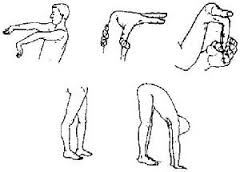In cases of spontaneous spinal cerebrospinal (CSF) leaks, an underlying weakness of the dura is usually suspected. Heritable disorders of connective tissue (HDCT) cause generalized weakness of connective tissues, including but not limited to the spinal dura. Thinner, more fragile dura can predispose to tears, resulting in leakage of CSF from the spine. Spinal imaging often reveals abnormalities of the spinal dura (meningeal diverticula, dilated nerve root sleeves, etc.) while surgical findings include a variety of abnormalities with associated attenuated dura.
Common clinical findings include:
skin: hyperextensibility, easy bruising, velvety texture, thin/transparent, poor wound healing
musculoskeletal: joint hypermobility, dislocations, scoliosis, spondylolisthesis, long limbs, flat feet
craniofacial: high arched palate, dental crowding
eyes: blue sclera, lens dislocation, retinal detachment, high myopia
heart/vascular: aortic or other arterial aneurysms, dissection or rupture
other: pneumothorax (collapsed lung)
A definite HDCT was diagnosed in 9 of 50 patients by geneticists in the series described in the publication below. Of these 9 patients:
4 had Ehlers Danlos, hypermobility type
2 had Ehlers Danlos, classic type
1 had Marfan syndrome
2 had unclassified heritable disorders of connective tissue
In an additional 8 patients, signs of connective tissue disorders were found without meeting strict diagnostic criteria for a known HDCT. Several of these were diagnosed with Benign Joint Hypermobility Syndrome. Note that there is current suspicion that Ehlers Danlos, hypermobility type and Benign Joint Hypermobility Syndrome represent the same disorder or spectrum of disorders.
Connective tissues are present throughout the body; many organ systems may be affected. Most serious and potentially life-threatening are vascular abnormalities, such as aortic aneurysms.
Importantly, only 2 of the patients in this series had a diagnosis of HDCT prior to the onset of symptoms related to their spinal CSF leaking. In the remainder, the spontaneous spinal CSF leak was the first noted manifestation.
Other studies have revealed other HDCT such as Polycystic Kidney Disease.
In patients that present with spontaneous spinal CSF leaks, an underlying Heritable Disorder of Connective Tissue should be considered since this may be the first obvious manifestation and there can be other serious complications. Screening for vascular complications should be considered.
Connective tissue spectrum abnormalities associated with spontaneous cerebrospinal fluid leaks: a prospective study.
Reinstein E, Pariani M, Bannykh S, Rimoin DL, Schievink WI.
Eur J Hum Genet. 2013 Apr;21(4):386-90.
doi: 10.1038/ejhg.2012.191.
Abstract
We aimed to assess the frequency of connective tissue abnormalities among patients with cerebrospinal fluid (CSF) leaks in a prospective study using a large cohort of patients. We enrolled a consecutive group of 50 patients, referred for consultation because of CSF leak. All patients have been carefully examined for the presence of connective tissue abnormalities, and based on findings, patients underwent genetic testing. Ancillary diagnostic studies included echocardiography, eye exam, and histopathological examinations of skin and dura biopsies in selected patients. We identified nine patients with heritable connective tissue disorders, including Marfan syndrome, Ehlers-Danlos syndrome and other unclassified forms. In seven patients, spontaneous CSF leak was the first noted manifestation of the genetic disorder. We conclude that spontaneous CSF leaks are associated with a spectrum of connective tissue abnormalities and may be the first noted clinical presentation of the genetic disorder. We propose that there is a clinical basis for considering spontaneous CSF leak as a clinical manifestation of heritable connective tissue disorders, and we suggest that patients with CSF leaks should be screened for connective tissue and vascular abnormalities.
PMID: 22929030
Full text PMC: 3598315


